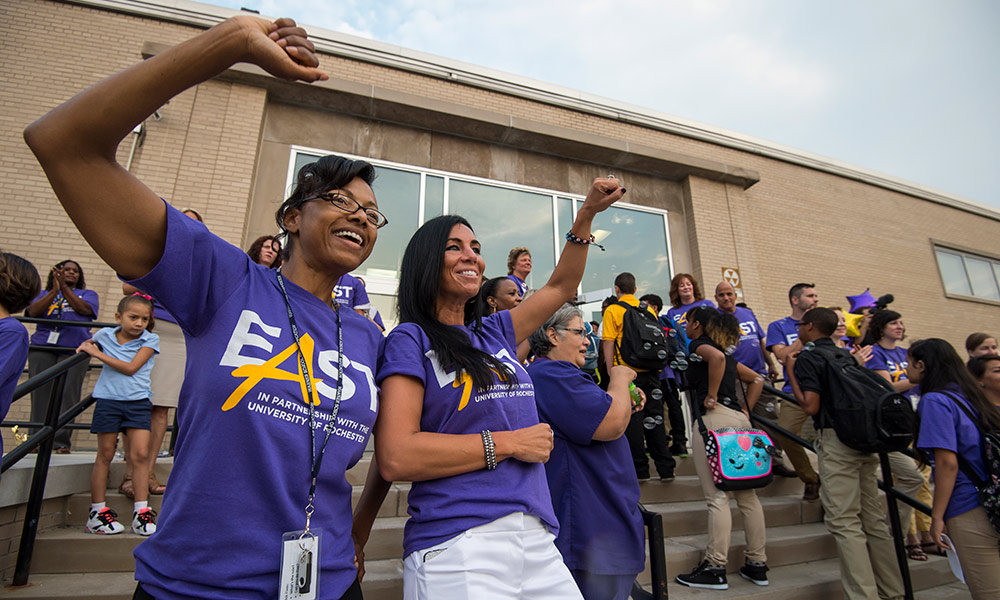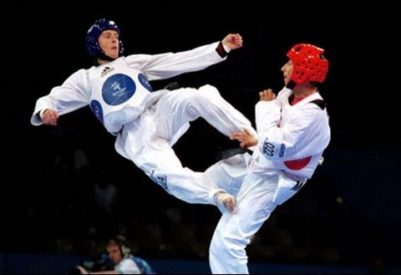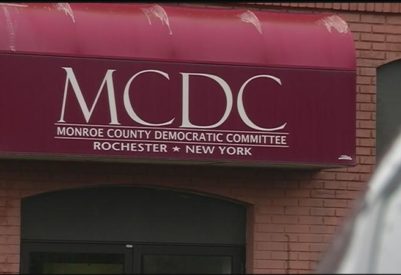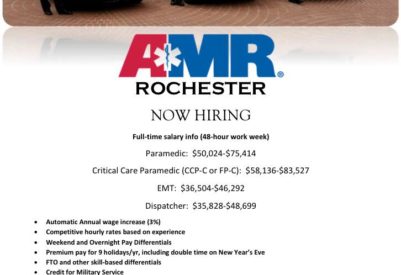
University of Rochester News Release
In 2014, a Rochester high school was on the brink of closure. Since then, a partnership with the University has helped East High School to forge a new culture and commitment to revival.
There’s an ease about Shaun Nelms ’13W (EdD) as he walks the corridors of East High School. At a commanding height of six foot three, in his navy-blue suit and misty pink
When Nelms began his role as school superintendent two years ago, East’s projected graduation rate for 2015–16 hovered at around 20 percent—just one out of every five kids who started as a ninth grader in 2012 was on target to leave with a diploma in June 2016. By 2020, the New York State Education Department would expect the graduation rate to reach 80 percent.
As East navigates toward that distant target, it’s not just the state that’s watching. It’s hopeful East alumni, whom Nelms briefs and leads on tours of the school. It’s the nearby businesses and nonprofits that are contributing time, money, and expertise. It’s the city school district, and the local press corps that’s followed East’s long decline, as well as the emergence of the educational partnership organization—the University of Rochester—that agreed to manage the school, under revamped curricula, renegotiated labor contracts with teachers, and a host of new initiatives, crafted over a yearlong period beginning in the summer of 2014.
It’s now the beginning of year three—and some key numbers have started to move. A major predictor of whether any student will graduate from high school is if that student passes the ninth grade. At the end of the 2014–15 school year, fewer than half of East's ninth graders did so. But in both years under the EPO, that number has climbed above 75 percent.
Meanwhile, suspensions and fights have dropped dramatically. More than 90 percent of students reported in a recent survey that they feel safe at East. Families have responded positively to new initiatives designed to support students socially and emotionally.
People who’ve worked at the school for years point to a discernable change in the whole culture and feel of the place. It’s less chaotic, says a social worker. The kids say “hello” more—and leave fewer messes in the cafeteria, a custodian observes. There’s less fighting, says a student. A teacher agrees. He hasn’t had to break one up in while—knock on wood, he says.
There are more bright spots. The partnership has brought expanded offerings and student participation in sports and the arts, and made improvements in culinary and optical programs that combine professional training and experience. The school newspaper, which had gone defunct, is back, under a new name, the Eagle Express. Eighth graders have traveled to Washington, D.C., and sixth graders to Montreal, on field trips that are par for the course in nearby suburban districts, but never part of the curriculum at East. This past summer, three East High science students watched as NASA’s SpaceX Dragon spacecraft shot off to the International Space Station with their science experiment aboard—one of just 21 projects from high school students in the United States and Canada to receive the honor.
But despite all these achievements, there’s sobering news as well. The graduation rate, among the most important metrics the state uses to measure the effectiveness of its public high schools, is still a hair under 50 percent. It’s just one illustration of how deep the crisis had become at East.
From his office in LeChase Hall, Stephen Uebbing, a professor of educational leadership at the Warner School of Education, watches the progress. Project director of the EPO, he was a key architect of the plan, and served as East superintendent in the first year of the partnership. He's buoyed by some of the progress. He notes, for example, that among the students in regular attendance for the past two years, the graduation rate last spring was closer to 60 percent. On the other hand, he concedes, “This is not risk-free. We can fail. We can fail in other people’s eyes even though we may succeed in our own eyes and in the eyes of the kids and teachers.”
Nonetheless, it’s the kind of project that a small number of universities with top-flight education schools are taking on. Johns Hopkins University has partnered with an East Baltimore K–8 school, now known as Henderson–Hopkins, while the University of California at Los Angeles has joined forces with multiple area schools.
Last spring, the University’s partnership with East attracted the attention of the leading trade publication, the Chronicle of Higher Education. In an interview, University President and CEO Joel Seligman explained the stakes—and why the complex project is so important to undertake. “The key is not to assume this is easy. This is really hard,” he said. But “if you only do safe projects, you don’t advance your communities.”





